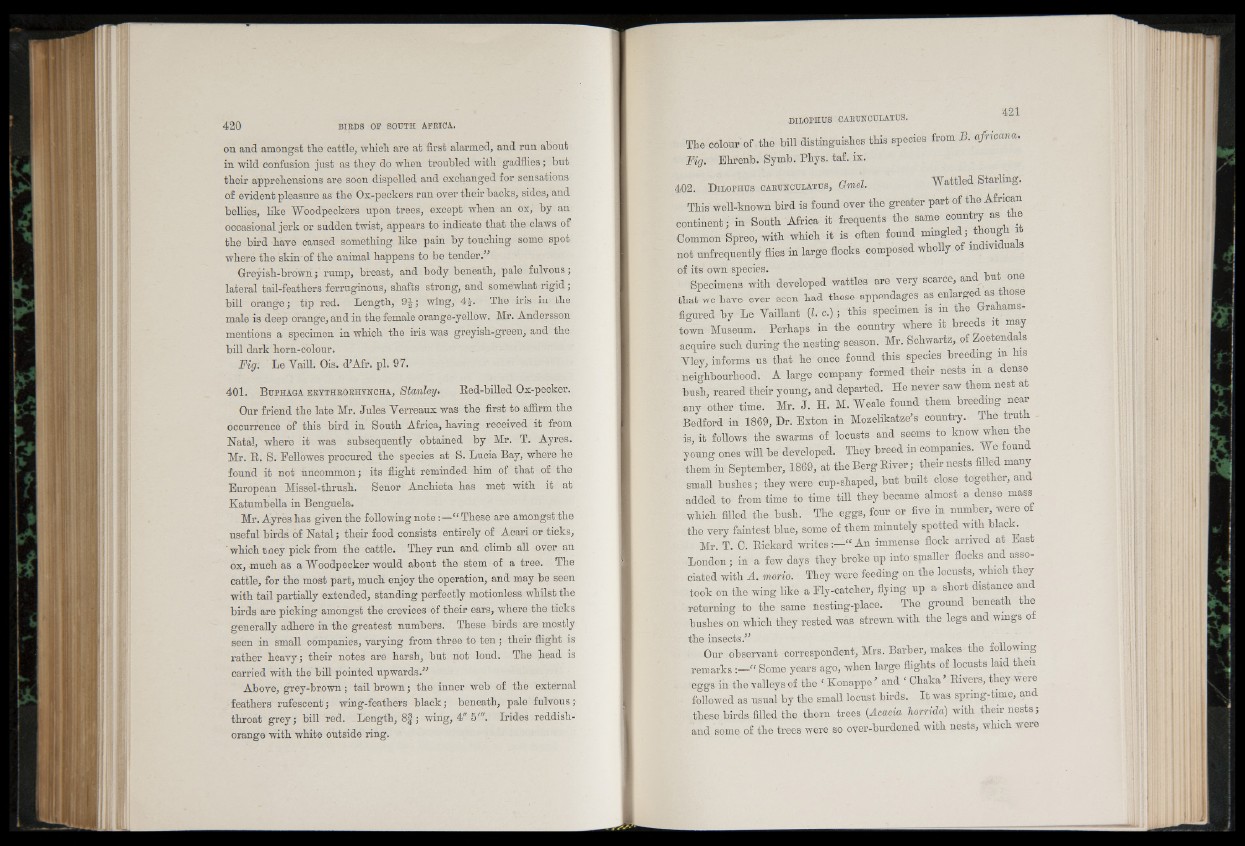
on and amongst the cattle, which are at first alarmed, and run about
in wild confusion just as they do when troubled with gadflies; but
their apprehensions are soon dispelled and exchanged for sensations
of evident pleasure as the Ox-peckers run over their backs, sides, and
bellies, like Woodpeckers upon trees, except when an ox, by an
occasional jerk or sudden twist, appears to indicate that the claws of
the bird have caused something like pain by touching some spot
where the skin'of the animal happens to be tender.'”
Greyish-brown; rump, breast, and body beneath, pale fulvous;
lateral tail-feathers ferruginous, shafts strong, and somewhat rigid;
bill orange; tip red. Length, 9 | ; wing, 4 j. The iris in the
male is deep orange, and in the female orange-yellow. Mr. Andersson
mentions a specimen in which the iris was greyish-green, and the
bill dark horn-colour.
FigI Le Vaill. Ois. d’Afr. pi. 97.
401. B uphaga ery th r o r h y n c h a , Stanley. Red-billed Ox-pecker.
Our friend the late Mr. Jules Yerreaux was the first to affirm the
occurrence of this bird in South Africa, having received it from
Natal, where it was subsequently obtained by Mr. T. Ayres.
Mr. R. S. Fellowes procured the species at S. Lucia Bay, where he
found it not uncommon; its flight reminded him of that of the
European Missel-thrush. Senor Anchieta has met with it at
Katumbella in Benguela.
Mr. Ayres has given the following note:—“ These are amongst the
useful birds of Natal; their food consists entirely of Acari or ticks,
which tney pick from the cattle. They run and climb all over an
ox, much as a Woodpecker would about the stem of a tree. The
cattle, for the most part, much enjoy the operation, and may be seen
with tail partially extended, standing perfectly motionless whilst the
birds are picking amongst the crevices of their ears, where the ticks
generally adhere in the greatest numbers. These birds are mostly
seen in small companies, varying from three to te n ; their flight is
rather heavy ; their notes are harsh, but not loud. The head is
carried with the bill pointed upwards."
Above, grey-brown; tail brown; the inner web of the external
feathers rufescent; wing-feathers black; beneath, pale fulvous;
throat grey; bill red. Length, 8 | ; wing, 4" 5"'. Irides reddish-
orange with white outside ring.
The colour of the bill distinguishes this species from B. afncana.
Fig. Ehrenb. Symb. Phys. taf. ix.
402. D ilo ph u s CARUNCULATUS, Gmel. Wattled Starling.
This well-known bird is found over the greater part of the African
continent; in South Africa it frequents the same country as the
Common Spreo, with which it is often found m i n g l e d ; though it
not unfrequently flies in large flocks composed wholly of individuals
of its own species.
Specimens with developed wattles are very scarce, a n d but one
that we have ever seen had these appendages as enlarged as t ose
figured by Le Vaillant § c.); this specimen is in the Grahamstown
Museum. Perhaps in the country where it breeds it ma,y
acquire such during the nesting season. Mr. Schwartz, of Zoetendals
Yley, informs us that he once found this species breeding m s
neighbourhood. A large company formed their nests m a dense
bush, reared their young, and departed. He never saw them lies a
any other time. Mr. J. H. M. Weale found them breeding near
Bedford in 1869, Dr. Exton in Mozelikatze’s country. The truth -
is, it follows the swarms of locusts and seems to know when t e
young ones will be developed. They breed in companies. We found
them in September, 1869, at the Berg River; their nests filled many
small bushes; they were cup-shaped, but built close together, and
added to from time to time till they became almost a dense mass
which filled the bush. The .eggs, four or five in number, were o
the very faintest blue, some of them minutely spotted with black.
Mr. T. C. Rickard w r i t e s A n immense flock arrived at East
London; in a few days they broke up into'smaller flocks and associated
with A. morio. They were feeding on the locusts, which they
took on the wing like a Ply-catcher, flying up a short distance and
returning to the same nesting-place. The ground beneath the
bushes on which they rested was strewn with the legs and wings of
tliG insGcts.
Our observant correspondent, Mrs. Barber, makes the following
remarks 1 Some years ago, when large flights of locusts laid then
eggs in the valleys of the f Konappe ’ and f Chaka ’ Rivers, they were
followed as usual by the small locust birds. It was spring-time, and
these birds filled the thorn trees (Acacia horrida) with their nests;
and some of the trees were so over-burdened with nests, which were